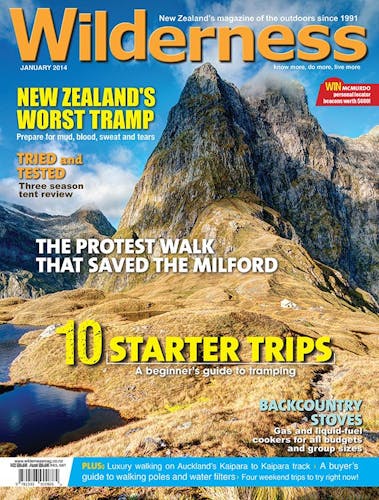Whilst the Canterbury township of Akaroa is best known for its French influence, just around the corner is a nature reserve of international importance – and it’s all thanks to one man
When I arrive at Hinewai Reserve, an hour’s drive from Christchurch, I find Hugh Wilson leaning on the front gate talking to some Swedish tourists who have just finished a walk through the reserve. Behind him are several wheelbarrows and evidence of a hard day’s slog. This, I later learn, is the veritable Hugh Wilson One Man Band. From writing and illustrating newsletters sent to the trust’s 1600 supporters, to clearing new tracks, chatting with visitors and erecting hilarious signage around the place, Wilson does it all with occasional help from contractors and carefully selected volunteers.
The Hinewai Reserve has its origins in a 109ha tract of unproductive farmland that was purchased by the Maurice White Native Forest Trust in 1987. When botanist Hugh Wilson arrived to take on the role of manager, he found only four hectares of original beech forest scattered in deep valleys throughout the reserve.
Back then, the task ahead seemed formidable. Years of marginal farming practices had resulted in goats, possums and gorse running amok. It was hard to know where to start, Wilson told me, as he recounted the effort that went into eradicating the goats, possums and gorse and establishing a network of tracks.
The eradication of gorse in particular raised a few eyebrows. “They said it couldn’t be done, and if it could somehow be done, that it would take years,” recounts Wilson as we survey the massive tracts of native bush that now run the length and breadth of the reserve. “We didn’t spray it, or graze it, or cut it out – instead we left it to grow.”
It might sound like an unorthodox gorse control policy, but it works.
As the gorse is left to grow, it gets bigger and taller feeding on the unrestricted sunlight. “It must think all its Christmases have come at once,” Wilson laughs. Eventually, the ageing gorse runs out of puff and is unable to regenerate. In the meantime, shade-loving native plants have started to grow in the shadows, and gradually make their way above the gorse, cutting off its vital sunlight supply. In only a few years, the gorse was all but annihilated and the native bush firmly established in its place.
In the 26 years since the reserve was started, an additional 1140ha of surrounding land has been acquired. The reserve now encompasses the Otanerito, Stony Bay and Sleepy Cove catchments as well as three summits that dominate the landscape. Part of the private Banks Peninsula Track runs through it, with those walkers entering the reserve near the Otanerito Homestead and exiting near Purple Peak Saddle.
Wilson’s dream is to purchase enough nearby land that visitors would be able to walk from one of the three summits down to the beach without exiting the reserve. “It might not happen in my lifetime,” he smiles, “but I’d like to think that it could happen one day.”
Wilson estimates that around 6500 people visit Hinewai Reserve each year. He doesn’t know the exact figure – while the reserve is 100 per cent privately funded, it is also 100 per cent open and accessible to the public. About 2500 of that number enter the reserve as part of the Banks Peninsula Track. The other 4000-ish enter through one of the reserve’s six entrances.
While he doesn’t set out to purposefully educate visitors about the importance of Hinewai (“I don’t have time to do that as well!”), it’s clear from online reviews and the visitors’ books that the reserve is well-known both locally and internationally for its ecological significance. An old woolshed on the property has been converted into a visitor centre and self-contained lodge that sleeps 12. The lodge is used regularly by tramping groups, scientists, volunteers and schools who want to experience Hinewai for themselves.
Sustainability and conservation are the main aims of the Maurice White Native Forest Trust which oversees the management of the reserve. Wilson is emphatic that conservation has priority and makes no bones about the fact that he would close the reserve in an instant if there was undue ecological risk from visitors. Composting toilets are de rigueur, rubbish and recycling are carefully sorted and plans are underway to have solar power installed.
A fire started by lightning in 2011 devastated much of the sub-alpine area of the reserve, but Wilson is quick to point out the silver lining in what could have been a catastrophic event: “At the time it was devastating – but it is incredible to realise that the native species are very quickly regenerating in that area and that the gorse is really on the back foot up there.”
Gorse isn’t the only thing that’s on the back foot at Hinewai. Wild goats haven’t been seen within the boundaries of the reserve for a decade. A recent possum trapping operation netted just 29 possums in 14 days. Wild deer have been spotted in the surrounding area, but the trust is confident that it has plans in place to protect the fledgling forest from any curious nibblers.
A network of well-established tracks presents a variety of options for both day visitors and groups staying overnight. Even the 10-minute stroll from the car park to the visitor’s centre reveals fuschia, flax, mountain holly, lancewood and five-finger – all readily identifiable thanks to the signage erected by the indefatigable Hugh.
The next time you’re at a loose end in Christchurch, or the chocolate croissants of Akaroa have lost their lustre, head to Hinewai Reserve. It’s a very special chapter in New Zealand’s ecological history and you won’t be disappointed.








